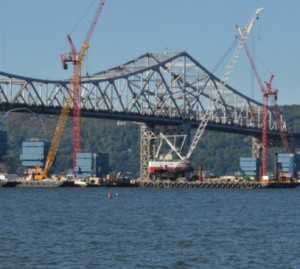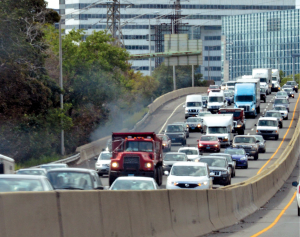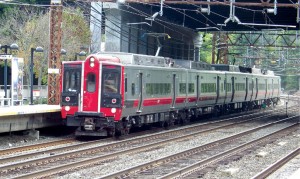If travel conjures romance, commuting is its evil twin.
From Byram to Bridgeport and north to Danbury in Connecticut and from Brewster to Bronxville and west across the Tappan Zee Bridge in New York, every point of the regional compass presents an opportunity to badmouth the roads, the rails and the bridges.
Images of Woody Guthrie”™s ribbon of highway and of the Atchison, Topeka and the Santa Fe never intrude upon the clipped and discourteous talk of what locals call simply “95,” “the Hutch,” “the Tap” and “the train.”
Crowds, snow and rain predictably turn commutes bad everywhere, but the Westchester/Fairfield region additionally suffers predictable local headaches like four balky, antique bridges on the New Haven Railroad line in Fairfield County and low-lying arteries along watercourses ”” notably the Saw Mill River and Bronx River parkways in Westchester County ”” that flood multiple times each year.
 The difficulties of getting around this region are not new. The Business Council of Fairfield County was founded in 1970 in part to address transportation issues. That was when Stamford”™s outgoing commuters dominated the scene; today more people commute into Stamford to work than leave it.
The difficulties of getting around this region are not new. The Business Council of Fairfield County was founded in 1970 in part to address transportation issues. That was when Stamford”™s outgoing commuters dominated the scene; today more people commute into Stamford to work than leave it.
A similar transportation-centric ethos underpins the Business Council of Westchester. Council President and CEO Marsha Gordon came onboard in 2001 from a transportation background that included work for MetroPool, which develops transportation and mobility plans for companies, municipalities and commuters.
“We can”™t ignore the problems,” Gordon said. “We need a comprehensive transportation system to have a growing, flexible economy. The ability to grow is based on the availability of a talented workforce that can get to work and that can get to work on time.”
The new Tappan Zee Bridge has now passed the halfway mark of construction and is slated to open by the end of 2016.
“For the Business Council, our No. 1 priority was building the new bridge with the appropriate mass transit,” Gordon said.
The Tappan Zee ”” “From day one,” according to Gordon ”” will feature bus rapid transit.
Gordon credited Gov. Andrew Cuomo with providing the muscle to get the long-planned bridge built. The supposed 50-year lifespan of the old Tappan Zee was crossed in the 1990s.
For Joe McGee, vice president for public policy and programs for the Business Council of Fairfield County “Washington, D.C., in 90 minutes is good. But it”™s more important to get from Stamford to Grand Central in 30 minutes. And it”™s not just Stamford that would benefit from high-speed rail. Places like Peekskill and Poughkeepsie would offer more options to commuters to live more broadly and still work centrally.”
Earlier this month, McGee hosted a sold-out Business Council forum titled “30 Minutes to Manhattan” in which the link between speed and real estate values was presented as equal to a $3,000 price uptick for homes near train stations for every minute lopped off the train ride to Manhattan.
That same forum ”” covered in FCBJ Sept. 14, “Grand Central in 30 Minutes” ”” revealed northern New Jersey is benefitting from a “wildly uneven” recovery, at least in part by promoting denser, mass transit-friendly zoning near rail stations.
“Linking communities is a plus,” McGee said. “These things matter. Ten or 15 minutes off a train trip is a big deal and people really know that.”
McGee mirrored Gordon”™s praise for Cuomo with a positive assessment of Constitution State Gov. Dannel Malloy”™s transit plans.
“Governor Malloy has asked for a $100 billion investment in transportation and we now have $1.7 billion in the current budget for rail. This is real ”” the first step. This money won”™t fix all the bridges, but it”™s a damn good beginning.
 “The new 21st-century commute features Wi-Fi and is reliable, safe and fast,” he said. “You”™re no longer doing 45 mph. You are doing 80 mph, and it is feasible. If we make these investments, the public is telling us they will use them. Even on the New Haven Line, with its sometimes old trains, saw ridership up 2 (percent) to 3 percent last year.”
“The new 21st-century commute features Wi-Fi and is reliable, safe and fast,” he said. “You”™re no longer doing 45 mph. You are doing 80 mph, and it is feasible. If we make these investments, the public is telling us they will use them. Even on the New Haven Line, with its sometimes old trains, saw ridership up 2 (percent) to 3 percent last year.”
In Westchester County, development east of downtown White Plains a generation ago on the so-called Platinum Mile on Westchester Avenue brought business-park development and traffic. The stretch of Interstate 287 between Interstate 684 and the Hutchinson River Parkway roughly coincides with the Platinum Mile. In 1979, that stretch of road saw 48,790 vehicles per day, according to the county. By 2010, the figure was 115,776, despite a recession at the time and IBM”™s withdrawal from the neighborhood in the early 1990s.
In the meantime, the ongoing remake of 55-year-old Interstate 287 has pushed to within three miles of the expressway”™s eastern terminus at Interstate 95.
A long-cherished dream of linking Long Island with either Westchester County or Fairfield County via a toll tunnel some 17 miles long remains just that, a dream. Its only presence today dates to web announcements from 2007, when its banker was listed as the now-defunct Bear Stearns. Rye and Oyster Bay were the towns to be linked at that time.
The Westchester Bee-Line bus system, with its 3,000 bus stops, is the second largest bus system in New York state after New York City”™s MTA. In 2012, it carried 32 million passengers, up 500,000 from 2011. Its 60 routes include commuter express trips to Manhattan, shuttles to corporate parks and buses that feed railroad stations. For express routes, the buses make use of what are termed “limited access” highways that include the Sprain Brook Parkway, Route 9A and Interstates 95 and 287.
Connecticut, which lacks county government, features the likes of Greater Bridgeport Transit, which this month is hosting informational meetings as part of a yearlong push to improve service. Its website offers routes and times plus word recent public survey data did not match data on which routes are actually used most often.
“We”™ll talk about that and present data at the public meeting,” the agency said.
When Joe McGee spoke of buses in the new transit equation, he likened them to “trains with rubber wheels,” with dedicated stations and lanes. He said one such route in Connecticut ”” New Britain to Hartford ”” was derided by critics as unwanted, but instead is attracting 17,000 daily riders.
“That dedicated busway is exceeding expectations,” McGee said. “It demonstrates the public is willing to use mass transit if it is clean, quick and reliable. It doesn”™t matter if it”™s a bus as long as it has its own station and runs on a schedule.” In the new world of bus rapid transit, he said, “buses look cool and they have wifi; they”™re not smelly old buses.”
Increased bus popularity and the rise of transit-oriented-developments ”” particularly near train stations ”” is part of commuting”™s never-ending evolution.
 Westchester County, where Scarsdale subdivided 150 acres into house lots in 1891, grew up feeding the New York City labor market. Westchester”™s out-commuters numbered 155,182 in 1990, a figure that jumped to 202,368 by 2010, the last year for which figures are available. But in-commuters grew more: from 132,108 in 1990 to 201,472 in 2010.
Westchester County, where Scarsdale subdivided 150 acres into house lots in 1891, grew up feeding the New York City labor market. Westchester”™s out-commuters numbered 155,182 in 1990, a figure that jumped to 202,368 by 2010, the last year for which figures are available. But in-commuters grew more: from 132,108 in 1990 to 201,472 in 2010.
Westchester”™s commuting relationship with the Bronx alone is telling.
In 1990, Westchester sent 1,000 more workers to the Bronx each day than the Bronx sent north. But by 2010, the Bronx was sending 10,000 more workers ”” for a total 36,315 ”” into Westchester than Westchester sent to the Bronx.
“Frequency and safety are key. But speed matters,” McGee said, adding 30 minutes from Stamford to Manhattan would provide “an enormous economic boost” and noted London, England, is investing in high-speed commuter service.
“We live in a global community. And the global economy is interested in schools, in neighborhoods and in commutes,” he said.
The New Haven Line, with its 38 million annual riders, is the busiest commuter line in the nation. It is thought of largely as a Connecticut line, but residents of Mamaroneck, New Rochelle and other Long Island Sound municipalities also use it as part of a shared regional transit picture. Added to which the Hutch becomes the Merritt and Interstate 95 hugs the sound from Pelham to Stratford.
The situation presents a spaghetti plate of challenges the Westchester Business Council and the Business Council of Fairfield County are trying to improve by working within, and irrespective of, their state borders.
From 11 a.m. to 2:30 p.m., Oct. 1 at General Re Auditorium, UConn Stamford, the two business groups are jointly hosting Mayor David Martin of Stamford, Mayor Toni Harp of New Haven, Mayor Noam Bramson of New Rochelle, Mayor Bill Finch of Bridgeport, Mayor Thomas Roach of White Plains, and Mayor Harry Rilling of Norwalk. The event is titled “Urban Development: The Mayor”™s Perspective.” Infrastructure and interdependency on transportation are on the docket.

















